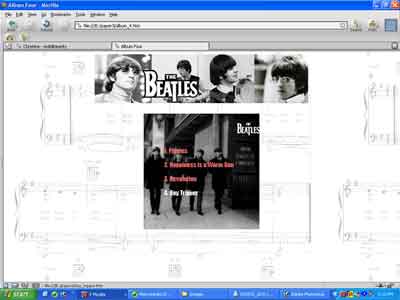B. Navigation via album.
Christine's decision to place the four main areas of her hypertext on
the index page creates opportunities for readers to experience the hypertext
in different ways (or for a single reader to have a significantly different
experience on a second reading). Where does one begin? While a paragraph-length
introduction on the index page
presents the reader with the basic argument, the hypertext is organized
as more of a network of ideas than a linear chain of reasoning. Each "record,"
as Christine calls a section, has a playlist of relevant Beatles songs
(screenshot 4). Selecting a thumbnail image of an album cover brings one
to the cluster of lexia that Christine has grouped as the tracks for that
"record."

screenshot 4
<1024x768>
<800x600>
C. Navigation via text link.
This particular navigation option seems to be constructed with transparency
in mind. Conventional academic essays are generally text-based. This hypertext
is an academic essay. The text-based link, "choose a record to spin,"
provides a basic point of entry for a reader uncertain about how to make
sense of the rest of the page. Interestingly, however, even this explicit
directive regarding navigation treats the reader as active. One must choose
how to read the hypertext. Selecting the link brings one to screenshot
3. This is the same node to which the play button on the audio player
skin is linked.
In addition to these important constructions of multilinearity
at the level of the hypertext's structure or organization, in-text links
enable the reader to follow paths within the actual text of the essay.
Christine
| return to multilinearity
| hybridity
|

